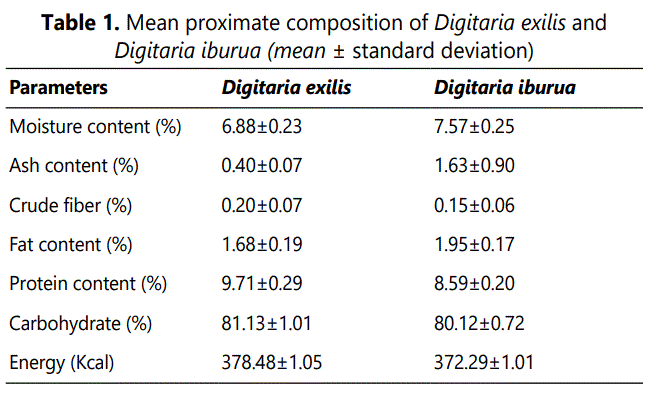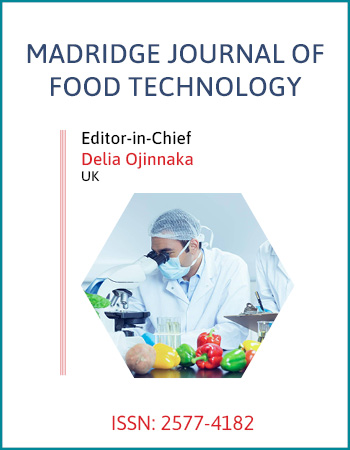Research Article
Proximate Composition of Digitaria species (exilis and iburua) in Bogoro L.G.A of Bauchi State
Department of Biological Sciences, Faculty of Sciences, Abubakar Tafawa Balewa University, Nigeria
*Corresponding author: Gayaunan D, Department of Biological Sciences, Faculty of Sciences, Abubakar Tafawa Balewa University, Nigeria, E-mail: gayaunansoolay@gmail.com
Received: October 18, 2023 Accepted: December 12, 2023 Published: December 22, 2023
Citation:: Abdul SD, Gayaunan D, Sawa FB, Yohanna MV. Proximate Composition of Digitaria species (exilis and iburua) in Bogoro L.G.A of Bauchi State. Madridge J Food Technol. 2023; 8(1): 210-213. doi: 10.18689/mjft-1000132
Copyright: © 2023 The Author(s). This work is licensed under a Creative Commons Attribution 4.0 International License, which permits unrestricted use, distribution, and reproduction in any medium, provided the original work is properly cited.
Introduction
Cereals are the most widely consumed food crops in the world and play a vital role in human nutrition (Awika, 2011). They provide a major source of carbohydrates, proteins, vitamins, and minerals. In Africa, cereals such as maize, sorghum, and millet have been the staple foods for centuries (Macauley and Ramadjita 2015: Dendy, 1992). However, there are other indigenous cereals such as Digitariaexilis (white) and Digitariaiburua (brown) that are highly nutritious and are gradually gaining recognition for their potential in food security and nutrition (Abdul and Jideani 2019: National Research Council, 1996). Exilis and iburua are small grain cereals that belong to the family Poaceae and are predominantly grown in West Africa. These cereals have gained increasing attention due to their high nutritional value and their ability to grow under unfavorable conditions (Adoukonou-Sagbadja et al., 2006).
West Africa use 300,000 ha for acha cultivation and yields 600-700kh/ha G1 (180,000- 210,000 tonnes) (Chukwuet al., 2018). It grows well on poor, sandy or ironstone soils in areas of low rainfall. Acha is probably the oldest African cereal (Echendu, 2009). Its harvested 2-4 months after sowing. Acha is primarily cultivated in West Africa and is one of the oldest African cereal crops. According to the Food and Agriculture Organization (FAO) of the United Nations, global acha production in 2019 was estimated to be 126,500 metric tons, with the majority (95%) produced in West Africa (FAO, 2021). The largest producers of acha in the world are Mali, Burkina Faso, and Guinea, with smaller quantities also produced in Senegal, Nigeria, and Togo (FAO, 2021).
In Nigeria, acha is grown in the northern part of the country, particularly in the states of Kebbi, Sokoto, Katsina, and part of Bauchi, Zamfara, and Kaduna (Jideani and Akingbala 1993)
Acha can be used for various purposes which include making local beverages, cook with legumes or vegetables, making of local drinks like gruel or pap. It is also use to prepare feeds for domestic animals and the husk is used as domestic fuel for cooking. It has greater Methionine (rich source of amino acid) content than other cereal protein (Ukimet al., 2012).
Despite the high nutritional value of exilis and iburua, their potential as a source of food and nutrition is still not fully explored, especially in terms of their proximate composition. It is one of the neglected plants in the world as people lack knowledge of its composition and its nutritional values, none availability of improved technologies the tinny nature of the seed and operations are done manually with zero mechanism. However, the research aimed at providing information on the proximate composition of exilis and iburua using 5 different accessions from Bogoro LGA of Bauchi state, Nigeria. In order to promote the consumption and utilization of these indigenous acha as a source of food, nutrition and most importantly to conserve the accessions.
Materials and Methods
The study was conducted in the Chemistry laboratory of the Department of Science Laboratory Technology of Abubakar Tatari Ali Polytechnic Bauchi, Wuntin dada campus, Bauchi state Nigeria and Abubakar Tafawa Balewa University.
Bauchi state occupies a total land area of 49,119 km2 (18,965 sq mi) representing about 5.3% 0f Nigeria’s total land mass and is located between latitude 9o 3ˈ and 12o 3ˈ north and longitudes 8o 50ˈ and 11o east. The state is bordered by seven states, Kano and Jigawa to the north, Taraba and Plateau to the south, Gombe and Yobe to the east and kaduna to the west.
Sources of acha and Sample Preparation
Acha samples were collected from local farmers in Bogoro Local government area of Bauchi state, which is located at the southern part of the state. A representative sample of the acha grains each was collected, and grind into a fine powder using a laboratory mill or blender to test for the following:
Moisture content determination:
• 2-5 grams of the ground acha sample was weighed and was placed in a drying oven preheated to 105-110ºC for 24 hours.
• After drying, the sample was removed and cooled in a desiccator before reweighing to determine the moisture content.
Ash content determination
• 2-5 grams of the ground acha sample was weighed and placed in a muffle furnace preheated to 550-600ºC for 5 hours.
• After combustion, the sample was cool in a desiccator before reweighing to determine the ash content.
Crude protein determination:
• 0.5-1.0 grams of the acha sample was digested in concentrated sulfuric acid using the Kjeldahl method.
• The digested sample was distilled, the distillate in an acid solution was collected, and titrated with sodium hydroxide to determine the nitrogen content.
• The nitrogen content was converted to crude protein using a conversion factor of 6.25.
Crude fat determination:
• The fat from the acha sample was extracted using a Soxhlet extractor and a suitable solvent (N-hexane)./p>
• After extraction, the solvent was evaporated and the residue was weighed to determine the crude fat content./p>
Crude fiber determination:
• The soluble fiber from the acha sample was extracted using weak acid.
• The residue was weighed after combustion to determine the crude fiber content.
Carbohydrate determination:
• The carbohydrate content was calculated by subtracting the sum of the moisture, ash, crude protein, crude fat, and crude fiber from 100%.
Data analysis
Analysis of variance (ANOVA) was used to determine the mean of the proximate composition of exilisand iburua. t-tests was used to determine the significance difference between the nutritional composition of exilisand iburua.
Results and Discussion
Table 1. shows the mean values and standard deviations for each parameter. The moisture contents of the two varieties accounted for 6.88% for white acha (exilis) and 7.57% of brown acha (iburua) respectively; these suggested that acha loses a considerable amount of water during storage resulting in a longer shelf life. The total ash value of (exilis) and (iburua) were 0.40 and 1.63 similar range was reported within the range for sorghum, millet, oats and wheat (DayakarRao et al., 2017). The crude fiber content for acha were (0.15 and 0.20% respectively), the findings is lower than the value of sorghum and maize but higher than the values of rice and millet (Ladan et al., 2018).
The crude fat value (1.68 and 1.95) is lower than the reported values reported by Ukim et al., 2021. The protein content of Digitaria exilis and Digitaria iburua were (8.59 and 9.71%), is low compared to the findings of Ukim et al., 2021, and also low in rice, millet, maize and sorghum (Chukwu and Abdul-kadir 2008). While the carbohydrate content of acha (80.12-81.13%) is almost at the same range as that of maize, rice, millet and sorghum (Chukwu and Abdul-kadir 2008).

Table 2, the t-test for moisture content yielded a p-value of 0.002, which is less than the significance level (alpha = 0.05). Therefore, there is a significant difference in moisture content between Digitariaexilis and Digitariaiburua. According to relevant work (Kone, 2008), moisture content can vary significantly between different crop varieties due to genetic factors and environmental conditions.

The t-test for ash content resulted in a p-value of 0.001, which is less than the significance level. Hence, there is a significant difference in ash content between Digitaria exilis and Digitaria iburua. This finding aligns with studies by (Tekaet al., 2012), where they observed variations in ash content among different Digitaria species. The crude fiber yielded a p-value of 0.125, which is greater than the significance level. Therefore, there is no significant difference in crude fiber content between Digitaria exilis and Digitaria iburua. This result concurs with the research by (Ndolo and Beta 2014), where they found similar crude fiber content in different Digitaria species. Similarly the fat content accounted for 0.035, which is less than the significance level and it’s in agreement with the work of (Basseyet al., 2023), where they reported variations in fat content among different Digitaria species.
The protein content yielded 0.002, less than the significance level. The result concurs with the research of (Osman et al., 2019), where they found variations in protein content among different Digitaria species. The carbohydrates yielded 0.256, this finding aligns with the finding of (Kaptsoet al., 2015), where they reported similar carbohydrate content in different Digitaria species.
Conclusion
Based on our findings, there was a significant difference in moisture content, ash content, fat content, and protein content between Digitaria exilis and Digitaria iburua. However, there were no significant differences in crude fiber content, carbohydrate content, and energy content between the two species. These findings indicated that while some proximate composition parameters differ significantly between the two varieties, others remain similar. More research should be conducted to find out the proximate composition of different accessions of Digitariain Bauchi and in Nigeria at large for food security and conservation.
References
- Abdul SD, Jideani AI. Fonio (Digitaria spp.) breeding. Advances in Plant Breeding Strategies: Cereals. 2019; 5: 47-81. doi: 10.1007/978-3-030- 23108-8_2
- Adoukonou-Sagbadja H, Dansi A, Vodouhè R, Akpagana K. Indigenous knowledge and traditional conservation of fonio millet (Digitaria exilis, Digitaria iburua) in Togo. Biodiversity & Conservation. 2006; 15: 2379-2395. doi: 10.1007/978-1-4020-5283-5_4
- Awika JM. Major cereal grains production and use around the world. Advances in cereal science: implications to food processing and health promotion. 2011; 1-13. doi: 10.1021/bk-2011-1089.ch001
- Bassey SO, Chinma CE, Ezeocha VC, Adedeji OE, Jolayemi OS, et al. Nutritional and physicochemical changes in two varieties of fonio (Digitaria exilis and Digitaria iburua) during germination. Heliyon. 2023; 9(6): e17452. doi: 10.1016/j.heliyon.2023.e17452
- Chukwu EC, Osuocha KU, Uhegbu FO. Nutrient composition and selected biochemical effects of Cnidoscolus aconitifolius leaf extracts in male albino rats. Journal of Forensic Research. 2018; 9(1): 1-7. doi: 10.4172/2157-7145.1000409
- Chukwu O, Abdul-Kadir AJ. Proximate chemical composition of acha (Digitaria exilis and Digitaria iburua) grains. Journal of food Technology. 2008; 6(5): 214-216.
- Dayakar Rao B, Bhaskarachary K, Arlene Christina GD, Sudha Devi G, Vilas AT, Tonapi, A. Nutritional and health benefits of millets. ICAR_ Indian Institute of Millets Research (IIMR). 2017.
- Dendy DAV. Composite flour-past, present, and future: A review with special emphasis on the place of composite flour in the semi-arid zones. Utilization of sorghum and millets. 1992; 502(67).
- Echendu CA, Obizoba IC, Anyika JU. Effects of germination on chemical composition of groundbean (Kerstingiellageocarpa harm) seeds. Pakistan Journal of Nutrition. 2009; 8(12): 1849-1854. doi: 10.3923/ pjn.2009.1849.1854
- Food and Agriculture Organization of the United Nations – FAO. (2021). New Food Balances. Retrieved in 2023.
- Jideani IA, Akingbala JO. Some physicochemical properties of acha (DigitariaexilisStapf) and iburu (D. iburuaStapf) grains. J Sci Food Agric. 1993; 63, 369-374. doi: 10.1002/jsfa.2740630317
- Kaptso KG, Njintang YN, Nguemtchouin MMG, Scher J, Hounhouigan J, Mbofung CM. Physicochemical and micro-structural properties of flours, starch and proteins from two varieties of legumes: bambara groundnut (Vigna subterranea). Journal of food science and technology. 2015; 52: 4915-4924. doi: 10.1007/s13197-014-1580-7
- Ladan Z, Oguogho L, Ako IN, Yakubu Y. Comparative studies of the nutritional value of Digitariaiburua and Digitariaexilis seed oils. Asian Journal of Applied Sciences, 2018; 6(4). doi: 10.24203/ajas.v6i4.5358
- Macauley H, Ramadjita T. Cereal crops: Rice, maize, millet, sorghum, wheat. 2015.
- National Research Council (NRC), 1996. Lost Crops of Africa (Vol. 1), Grains. National Academy Press, Washington, DC, USA.
- Ndolo VU, Beta T. Comparative studies on composition and distribution of phenolic acids in cereal grain botanical fractions. Cereal Chemistry. 2014; 91(5): 522-530. doi: 10.1094/CCHEM-10-13-0225-R
- Osman A, Kamaldeen BA, Osafo ELK, Attoh-Kotoku V, Abdul Aziz Y. Biomass Yield and Chemical Composition of Red Napier Grass Harvested at 3 Different Dates After Planting in the Forest Zone of Ghana. Ghanaian Journal of Animal Science. 2019; 10(1).
- Oyeyinka SA, Singh S, Amonsou EO. Physicochemical properties of starches extracted from bambara groundnut landraces. Starch‐ Stärke, 2017; 69(3-4): 1600089. doi: 10.1002/star.201600089
- Teka H, Madakadze IC, Angassa A, Hassen A. Effect of seasonal variation on the nutritional quality of key herbaceous species in semi-arid areas of Borana, Ethiopia. Indian Journal of Animal Nutrition. 2012; 29(4): 324-332.
- Ukim CI, Ndelekwute EK, Kennedy OO, Ayuk AA, Agwunobi LN. Potential of acha (Digitaria spp.) grains as feedstuff for chicken diets in the wake of Covid-19 pandemic challenges: A review. Nigerian Journal of Animal Production. 2021; 48(4): 94-106. doi: 10.51791/njap.v48i4.2986
- Ukim CI, Ojewola GS, Obun CO, Ndelekwute EN. Performance and carcass and organ weights of broiler chicks fed graded levels of Acha grains (Digitaria exilis). Journal of Agriculture and Veterinary Science. 2012; 2(1): 28-33.


